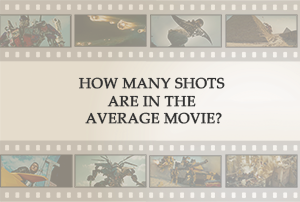 Last week, I experienced the latest Transformers movie. The constant fast-paced action and frenetic editing got me thinking just how many shots were in that movie.
Last week, I experienced the latest Transformers movie. The constant fast-paced action and frenetic editing got me thinking just how many shots were in that movie.
Sadly, I lost count during the screening but afterwards, I resolved to look into the broader question: How many shots are in the average movie?
How many shots are in the average movie?
Let’s start by directly answering the question which started this research. Across all the movies I could find data for (released 1997 to 2016), the average number of shots in a movie is 1,045. But I’m sure regular readers know that I’m not going to end the article purely because I’ve answered the original question!
Unsurprisingly, there are huge variations between movies. Russian Ark somewhat skews the average, seeing as it’s a 99-minute movie told in one continuous shot, whereas Doomsday held the record for the most shots in the dataset, at 4,052.
If we break the results down by genre, we can see that documentaries have the lowest number of shots (an average of 491 shots), followed by music-based movies (814) and romantic films (869). At the other end of the spectrum, action films have the highest number of shots (1,913), followed by sci-fi (1,701) and adventure (1,681).
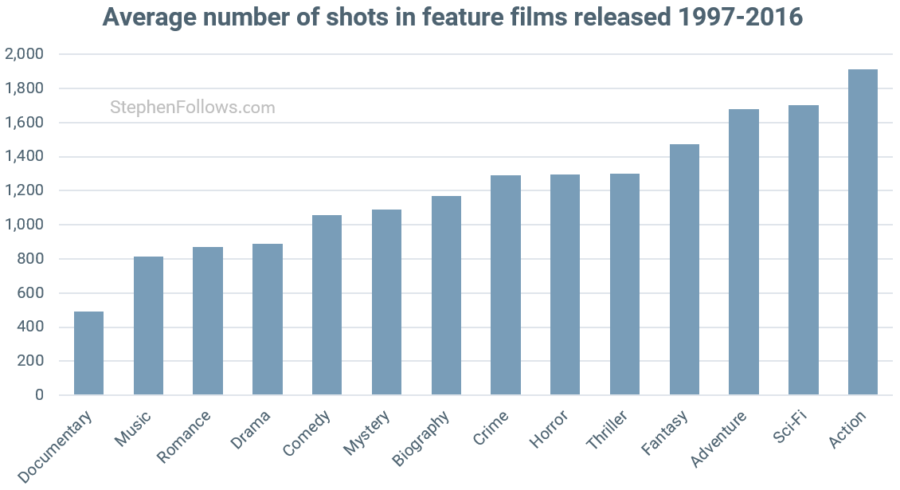
By now, you may have started to wonder what the correlation is with running time. Documentaries are often shorter than action films and this would affect the total number of shots. So let’s change our metric and look at the length of the average shot in seconds.
(If you want to read more about the running time of movies then you may enjoy my article from last year entitled Are movies getting longer?).
How long is the average shot in a movie?
With this metric, we see the same cohort at the ‘fast-paced’ end – action films have an average shot length of 4 seconds, followed by adventure (5.1 seconds) and sci-fi (6.2 seconds).
At the slow-paced end, we now see that horror films have the fewest cuts, with an average shot length of 15.7 seconds (almost four times longer than action movies!)
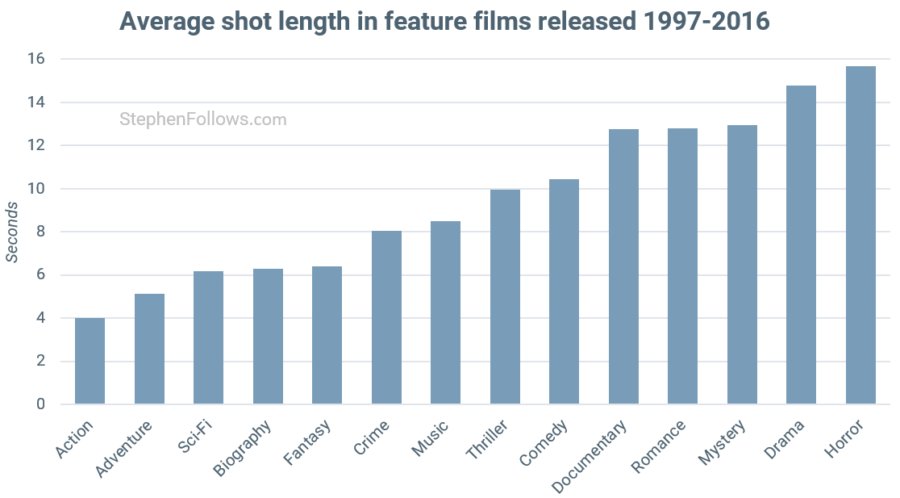
I’d love to be able to see how this changes over time, but sadly there isn’t data on enough movies to draw conclusions. However, we can look at particular film series and see how they have evolved over time. Both the Iron Man and Bourne series saw a significant reduction in the length of the average shot over the course of their first three movies.
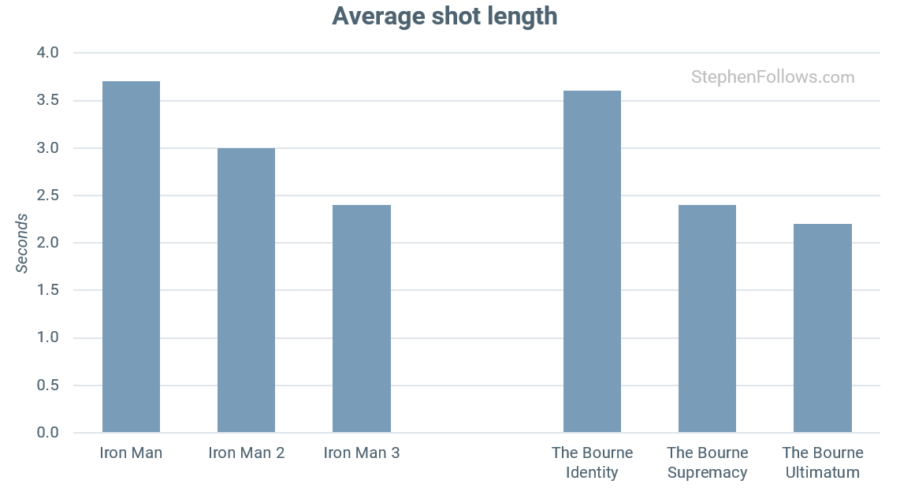
Some directors frequently cut
One of the ways we can measure the vast differences between the styles of different directors is to look at how they edit their movies (or, more correctly in most cases, how they instruct their editor to cut their movies).
The chart below compares the average shot length for selected directors from the dataset. The director with the shortest average short length is Paul W.S. Anderson (he of the Resident Evil series), with an average of just 2.4 seconds. On the other end of the spectrum is Michael Haneke whose average is a whopping 26.4 seconds (his movie Code Inconnu has just 191 shots through its two-hour running time).
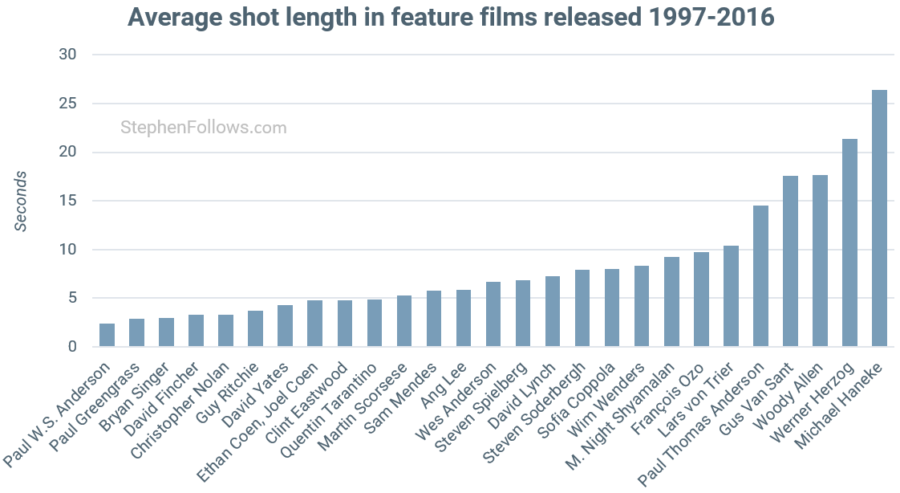
Whatever Transforms
To end this piece, let’s compare two movies which came out in cinemas only a few days apart – Woody Allen’s Whatever Works (starring Larry David) and Michael Bay’s Transformers: Revenge of the Fallen (starring a truck which is also a robot).
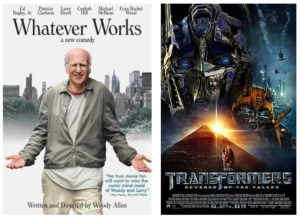 Whatever Works
Whatever Works
- Total number of shots = 318
- Average shot length = 16.5 seconds
- Shortest shot = 1.1 seconds
- Longest shot = 175.1 seconds
Transformers: Revenge of the Fallen
- Total number of shots = 2,503
- Average shot length = 3.4 seconds
- Shortest shot = 0.2 seconds
- Longest shot = 35.8 seconds
The chart below shows the length of the shots in each movie, expressed as a percentage of all shots (i.e. 15% of all shots in Transformers 2 were between 1 and 1.5. seconds long).
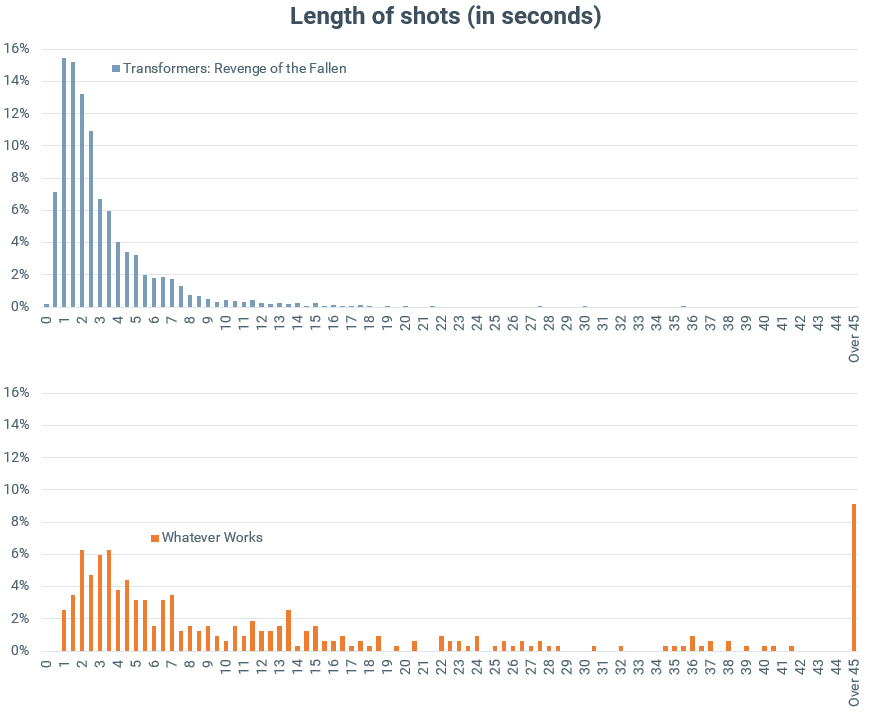
Notes
The raw data for today’s research came via the crowd-sourced Cinemetrics database. I found and cleaned the relevant data (i.e. some movies were surveyed a few times so I looked into which seemed the most accurate), I added metadata and analysed the new dataset. I’m very grateful to the guys who built and manage the site, and to the 1,037 individual submitters who added data which ended up in my final research.
A special shout out should go to the submitters who surveyed a large number of movies. The following people all surveyed at least 20 of the movies I researched today: Adrian Tomas Samit, Cid Vasconcelos, Erik, Mohsen Nasrin, Eric T. Jones, Radomir D. Kokes, Barry Salt and Stew Fyfe.
This topic is always a bit of an inexact science. Measuring the exact number of shots can be tricky, it’s prone to user error, there is no second step verification of submitted data and we don’t have information on the vast majority of movies made. Nonetheless, I feel that we have enough data to discuss the overall trends shown above.
Epilogue
Today’s topic was sparked by watching the new Transformers movie. My taste in movies is pretty broad and so certainly includes an interest in the crash-bang-wallop school of filmmaking. I can see why some cinephiles treat the movies of Michael Bay et al with disgust but I think they’re missing a rich tapestry of cinematic spectacle.
To help, here are a few tips when watching a film of the ilk of Transformers 5: The Last Knight:
- See it in IMAX or don’t bother.
- Think of it as a fireworks show, not a piece of narrative art.
- Whatever ridiculous leap of logic the filmmakers are asking you to buy – go with it.
- Know that it’s ok to enjoy it, so long as you provide withering critique to your cinephile friends afterwards.
With those tips in mind, here is some pretty Bayhem…

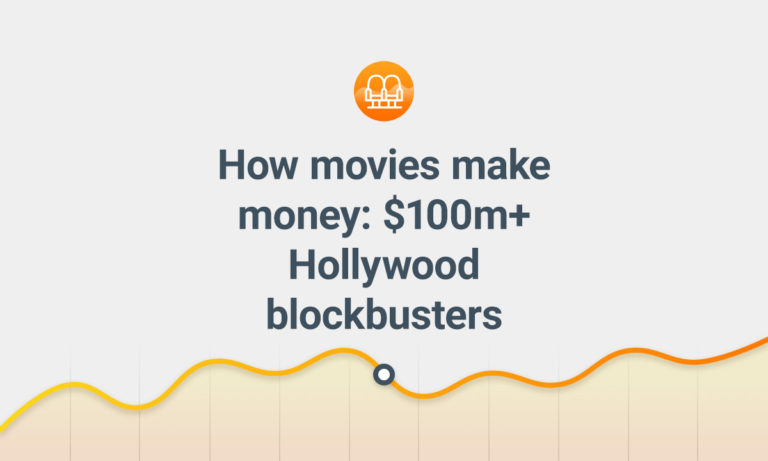
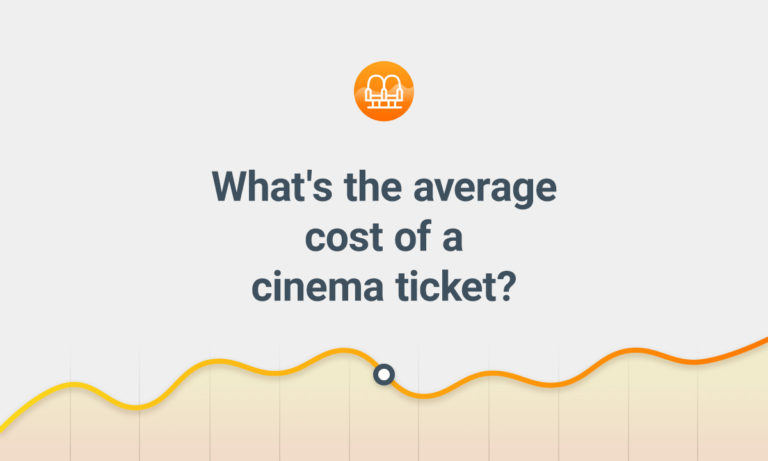
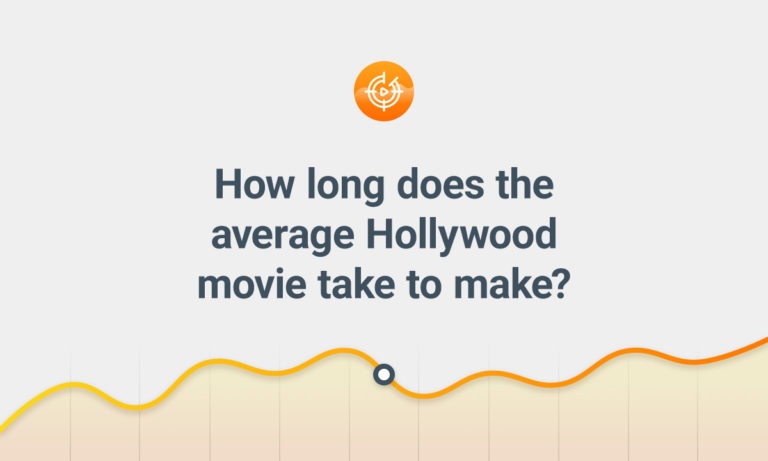

Comments
Thanks chap, really interesting read… A question furthering this line of enquiry – how many shots on average for a film nominated for an editing Oscar?
Often it can feel like an Oscar goes to “Most” rather than “Best” in many categories. My prejudice was that Hacksaw Ridge, being a full-on war film, would have more edits in it, at a faster average, than either Arrival, La La Land, Hell Or High Water or Moonlight… But having now seen it, I wonder if my preconception was wrong… Be lovely to know!
Awesome idea, Chris!
I can’t say for certain as there may be a number of other factors at play. However, I ran a quick test and you may be on to something. I compared three sets of films within my datasets – All dramas, dramas with an Oscar Best Picture nomination and dramas with an Oscar Best Picture win (all 2000 to date). Here are the results…
Dramas = 739 shots, average length was 14 seconds
Dramas with an Oscar Best Picture nomination = 1,299 shots, average length was 5.9 seconds
Dramas with an Oscar Best Picture win = 1,705 shots, average length was 4.8 seconds
Thank you 🙏
Very interesting as a film maker to read about this
Thank you for the great info.
Stephen, Do you think there is any correlation between average number or length of shots and box office success?
Good question. I think the hard thing would be disentangling it from other factors. For example, if we found correlation then it would hard to say if it were truly about the number of shots or down to the genre etc.
Many years ago, I worked on a home video version of ON HER MAJESTY’S SECRET SERVICE, and I’m fairly certain it went north of 3500 cuts in 2.5 hours. We had several individual reels that were 800 cuts, which is very high, particularly for a 1960s film.
Any data on the number of setups/scenes vs shots- a 3 camera single setup/scene could obtain 3 shots etc..
See where I am trying to get to? Average number of scenes..
Thanks! Great article!
Me too!! Somebody? Average number of scenes?
Compare this with the typical shot length in a TV commercial (just over 1 second I believe and a music video (2-3 seconds in most cases I think). Really a wide variation based on genre which I never noticed before. In TV News it is rare for a shot to last more than 45 seconds even if it is live. This was never really covered in my film school classes (many years ago) except with the adage that a shot (or camera angle/scene) should only be as long as it needed to be to convey the message of the story. The emphasis was on more shots (shorter ones) and to assist the director and actors in telling the story with the camera, but not making the camera work part of the story. I’ve worked on a lot of productions with 1 or 2 cameras and some with more than a dozen.
Taking the cue from your epilogue:
The Michael Bay hate train is only relevant to understand how arrogant and mob-minded a lot of so called “cinema lovers” truly are.
No, Bay is no Kurosawa or De Sica – but here’s the kicker: he is not trying to be any of that. He is not pretentious, he is not trying to pass his films for high brow art. But on top of that, pretty much like with any auteur, you know exactly what sort of audiovisual experience you’re going to get when you chose to see one of his films.
I haven’t seen the last 2 Transformers flicks, but the first and the third ones are beyond solid popcorn entries. In fact, I’d much rather rewatch one of those than rewatch one of the Avengers or any of the bubonic plague of super-hero stuff that, save for Nolan’s entries, all taste exactly the same and, contrary to what Bay offers, have atrocious cinematic language.
He has the dramatic sensibility of a teenager, he does live action cartoons – but he does them pretty well. Nothing wrong with that.
Wow this is a great read. I have two small kids (5 & 7) and while I love the old kids movies I HATE the new ones and it is mainly because the editing makes my head spin. Never mind the snotty attitude or overwhelming boobs in the shows aimed at little kids. If I could have it I want to see this same chart done with kids movies. I would make it myself if I could figure out a sound way to find or get the data. I have considered picking a segment of say ten minutes from a movie today (say Little Mermaid) and an older one (like Annie) and then something older (like the Wizard of Oz). But now I am thinking the whole movie would be a better measure.
At any rate this was wonderful to stumble upon. Thanks!
Hi Stephen,
would it be a big deal for you to add tables with all data, in addition to graphs, i.e., for each genre: a. duration (in minutes, seconds, or whatever), b. length (i.e., number of shots), and c.) average shot length ? Since you offer the graphs, this should be no troublesome favor you could do for your readers. The mega version would be to offer this – genre per gebre – for each individual movie; but also the corpus data would be helpful, as a minimum
Thanks a lot in advance,
Peter
Stephen, I was just wondering how you collected this data? What is your source? I am actually working on my AP Research project for a class and this data would be great to use, but I would have to know it’s sources. If you could help me out with that information it would be very helpful for this project. Thank you.
Hi Joe. The details of the data (and links to the site) are in the Notes section at the end of the article.
hey…can u please tell that how story affect with number of shot in a scene?
for example: more number of shots in a scene give more energy to the scene…….what do you think?
Hi Nakul. I’m afraid the data doesn’t reveal that and so I don’t want to overstep my purview. I’d suggest talking with editors and reading ‘In The Blink of a Eye. by Walter Murch
Question: Is this an examination of how many “shots” there are in these features or “cuts” (as in edits)?
It’s a confusing set of terms, that’s for sure! It’s shots in so far as if a film were to be made up of two shots then it would have one edit but in this research would show up as ‘2’. But it’s not the number of camera sets ups (i.e. another use of the word ‘shots’).
another interesting date would be the comparison of the number of cuts between a movie say in the 60’s or 70’s and now. That number probably doubled.
Thank you for prompting me to look back at this article. The most interesting thing would be whether average shot duration is decreasing over time (I bet it is) but I read your caveat about there not being enough data. I wonder if it would be possible to see if directors have reduced their average shot length over time?
thank you, very interesting. If I may be a bit of a smart ass here, I believe the use of the word “shot” is incorrect. What you were comparing is the count of interruptions within the film material. In my understanding – and I believe this is the definition of the term – shot is the material between “action” and “cut” delivered to the editing room. To stay with your example: if M.Bay’s editor interrupts the stunt of a flying car with material from 4 other cameras of the same stunt and a close-up on the driver, say seven times then we have used 6 shots yet we have 15 interruptions or cuts in the movie. And yes, this is highly interesting in your article how the trust in a single shot is decreasing over time.
Seems to me that, over time, the number of cuts (you call them (shots:) per minute of motion picture has dramatically increased in recent decades, particularly of course in action pictures. Electronic editing has facilitated much of this. Do you have data on this?
I too questioned the use of the word shot vs. cut. Thanks for explaining it. Stephen: Do you have the breakdown of shots and/or cuts per scene?
Seems to me that, over time, the number of cuts (you call them “shots”) per minute of motion picture has dramatically increased in recent decades, particularly of course in action pictures. Electronic editing has facilitated much of this. Do you have data on this?